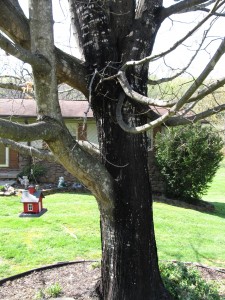You see or hear a sapsucker tapping in a yard tree and pay little attention to it. The bird perforates the tree or shrub trunk and main branches with numerous shallow holes, similar to a riveter working with sheet metal. A sapsucker feeds on the cambium sap and on insects under the bark.
The holes are deep enough to cause sap leakage, particularly in the winter months when sap pressure in maples (also dogwoods, elms, birches and yellowwoods) is the highest. The sugary sap coats the trunk, and sooty mold fungi grow over the sap secretions. The result is a yucky black stain similar to pitch!
What to do? Nothing!! The sapsucker is at work, doing his/her natural thing. Sapsuckers are members of the woodpecker family. They serve an important function: listening and removing damaging insect borers which may be feeding on the tree sapwood.
Unfortunately, sapsucker feeding does not always indicate that the bird has found insects inside the tree. Yes, the numerous holes are unsightly, but are not injurious to the life of the tree. The black sooty appearance on the trunk should wash off in the months ahead.
According to University of Arkansas Extension horticulturist Dr. James Robbins, favorite tree species for sapsuckers include maple (Acer spp.), pecan (Carya), birch (Betula spp.), pine (Pinus spp.), elm (Ulmus spp.) and some oaks (Quercus spp.). Sapsuckers are attracted to old holes and other bark injury and may return to the same tree(s) for several years.


 Posted in
Posted in 
